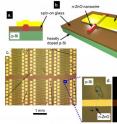Scientists demonstrate method for integrating nanowire devices directly onto silicon
Related images
(click to enlarge)
Applied scientists at Harvard University in collaboration with researchers from the German universities of Jena, Gottingen, and Bremen, have developed a new technique for fabricating nanowire photonic and electronic integrated circuits that may one day be suitable for high-volume commercial production. Spearheaded by graduate student Mariano Zimmler and Federico Capasso, Robert L. Wallace Professor of Applied Physics and Vinton Hayes Senior Research Fellow in Electrical Engineering, both of Harvard's School of Engineering and Applied Sciences (SEAS), and Prof. Carsten Ronning of the University of Jena, the findings will be published in Nano Letters. The researchers have filed for U.S. patents covering their invention.
While semiconductor nanowires---rods with an approximate diameter of one-thousandth the width of a human hair---can be easily synthesized in large quantities using inexpensive chemical methods, reliable and controlled strategies for assembling them into functional circuits have posed a major challenge. By incorporating spin-on glass technology, used in Silicon integrated circuits manufacturing, and photolithography, transferring a circuit pattern onto a substrate with light, the team demonstrated a reproducible, high-volume, and low-cost fabrication method for integrating nanowire devices directly onto silicon.
"Because our fabrication technique is independent of the geometrical arrangement of the nanowires on the substrate, we envision further combining the process with one of the several methods already developed for the controlled placement and alignment of nanowires over large areas," said Capasso. "We believe the marriage of these processes will soon provide the necessary control to enable integrated nanowire photonic circuits in a standard manufacturing setting."
The structure of the team's nanowire devices is based on a sandwich geometry: a nanowire is placed between the highly conductive substrate, which functions as a common bottom contact, and a top metallic contact, using spin-on glass as a spacer layer to prevent the metal contact from shorting to the substrate. As a result current can be uniformly injected along the length of the nanowires. These devices can then function as light-emitting diodes, with the color of light determined by the type of semiconductor nanowire used.
To demonstrate the potential scalability of their technique, the team fabricated hundreds of nanoscale ultraviolet light-emitting diodes by using zinc oxide nanowires on a silicon wafer. More broadly, because nanowires can be made of materials commonly used in electronics and photonics, they hold great promise for integrating efficient light emitters, from ultraviolet to infrared, with silicon technology. The team plans to further refine their novel method with an aim towards electrically contacting nanowires over entire wafers.
"Such an advance could lead to the development of a completely new class of integrated circuits, such as large arrays of ultra-small nanoscale lasers that could be designed as high-density optical interconnects or be used for on-chip chemical sensing," said Ronning.
Source: Harvard University
Other sources
- Method For Integrating Nanowire Devices Directly Onto Silicon Developedfrom Science DailySat, 10 May 2008, 22:28:16 UTC
- Scientists demonstrate method for integrating nanowire devices directly onto siliconfrom PhysorgThu, 8 May 2008, 20:56:11 UTC

